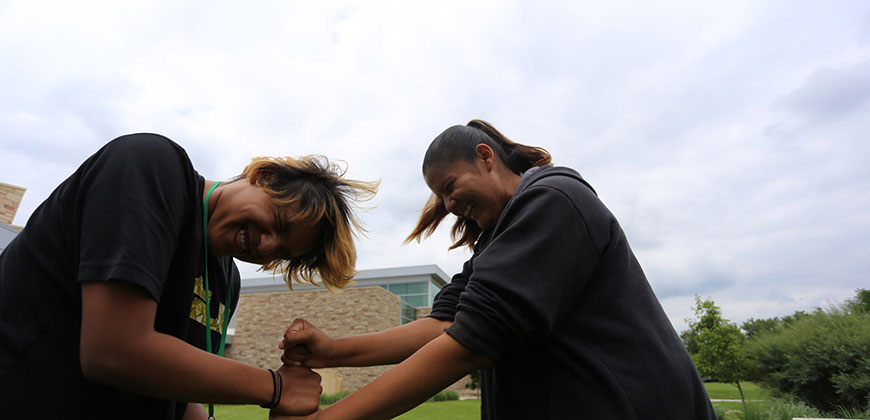
American Indian youth visited campus last year to learn media and leadership skills through a program hosted by the Tri-Ethnic Center for Prevention Research.
American Indian middle and high school students who live on or near reservations are at higher risk for drug and alcohol abuse than their non-Native counterparts. For decades, social scientists at CSU’s Tri-Ethnic Center for Prevention Research have sought to understand, measure and help solve this pervasive, multigenerational problem.
The researchers are launching their latest effort to gather comprehensive data on drug and alcohol use within this unique and at-risk population. The Tri-Ethnic Center has been awarded a five-year, $2.98 million grant from the National Institute on Drug Abuse (NIDA), part of the National Institutes of Health, to conduct surveys with middle and high school Native youth. This spring, they’ll launch a nationwide survey that targets schools on or near American Indian reservations. Participating schools receive about $3,000, along with an individualized report summarizing students’ responses and comparing them with national aggregated data.
“Our hope is that our survey results can be used to matter – to make real changes for these kids,” said Senior Research Scientist Linda Stanley, a member of the project team.
The Tri-Ethnic Center, housed in the College of Natural Sciences’ Department of Psychology, has been administering surveys like this since 1975, when the center was awarded its first NIDA grant. It is the second longest-running NIDA-funded study, and the only study that explores the attitudes, values, beliefs and behaviors regarding substance use among national American Indian rural youth.
Past survey results a ‘wake-up call’
NIDA Director Nora Volkow has blogged about past CSU survey results, describing them as a “wake-up call.”
“High substance use in American Indian communities contributes to a range of social problems including violence, delinquency, and mortality from suicide or alcohol or other substance abuse,” Volkow wrote. “Thus these findings alert us to the urgency of implementing prevention programs in these communities. Moreover, given that American Indian youth are already using drugs and alcohol at high levels by the time they become teenagers, we clearly must do more to intervene at an earlier age.”
To inform their work, CSU researchers have used comparative data from “Monitoring the Future” surveys administered by University of Michigan researchers. The results have consistently shown higher prevalence of drug and alcohol use in American Indian 8th- and 10th-graders compared with national, non-native averages.
For example, from 2009-2012, 56.2 percent of American Indian 8th graders and 61.4 percent of 10th graders had used marijuana, compared with 16.4 percent of 8th graders and 33.4 percent of 10th graders in the Monitoring the Future survey. And American Indian students’ annual heroin and OxyContin use was about two to three times higher than national averages in those years.
Longitudinal range of data
Part of the value of administering such surveys since the 1970s is the longitudinal range of data the researchers have access to. Over time, they’ve noticed ebbs and flows of certain substances – from crack, to inhalants, to heroin and methamphetamines.
“There are some things we find that mirror what national results show,” said Randall Swaim, Senior Research Scientist and director of the Tri-Ethnic Center. “There are other, unique aspects to substance use among American Indian kids on reservations that really require a special focus for those problems.”
The CSU research team is as much dedicated to science-based, comprehensive data-gathering as they are to using that data to create effective prevention programs.
They’re engaged in a related effort to build a program called “Be Under Your Own Influence” that trains American Indian teens to become role models. Some of the selected 11th-graders visited CSU last year for workshops and activities about using multimedia tools to support leadership skills. The researchers hope such efforts will plant seeds for continued, grassroots success in individual communities.
“We’re hoping they will take the ball, and run with it,” said survey team scientist Susan Harness.
For more information, contact Randall Swaim at Randall.Swaim@colostate.edu or Susan Harness at susan.harness@colostate.edu.